![]()
![]()
![]()
Use LEFT and RIGHT arrow keys to navigate between flashcards;
Use UP and DOWN arrow keys to flip the card;
H to show hint;
A reads text to speech;
17 Cards in this Set
- Front
- Back
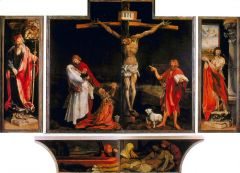
|
Matthias Grunewald Isenheim Altarpiece Closed Crucifixion, flanked by Sts Sebastian and Anthony Abbot 1510-15 hoo boy complex polyptic altarpiece at antonite monastery where monks treated sufferers of st. anthony's fire, now known as "urgotism" this altarpiece sat in hospital church. the suffering could see themselves in the suffering christ goes through. crucifixion represented with extreme gruesomeness, all the cuts on his skin from the thorns, the nail wounds gushing blood and the mangled anatomy from being suspended like so. |
|
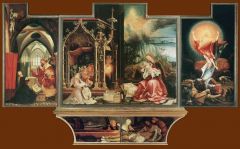
|
Matthias Grunewald Isenheim Altarpiece Open I Annunciation, Virgin and Child with Angels, Resurrection 1510-15 happier opening, full of pinks and reds and lights. opened on holidays and stuff. absolutely frontal resurrection, not naturalistic, like an atomic explosion of glory. christ's wounds shine and he floats, weightless |
|
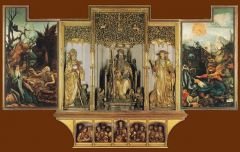
|
Matthias Grunewald Isenheim Altarpiece Open II Temptation of St. Anthony Abbot 1510-15 relief sculpture with anthony abbot at center. temptation scene- anthony is set upon by terrifying demons who tempt him to fear and give in to despair. northern artists love the demons and sh!t, it's like... just let your imagination run wild. like frickin jim henson puppets. demons have wounds resembling the sufferers... idk how that's comforting but whatever. |
|
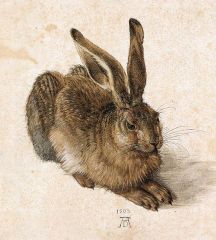
|
Albrecht Durer Hare 1502 durer did lots of detailed nature studies... yea... |
|
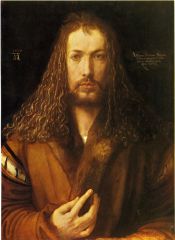
|
Albrecht Durer Self Portrait 1500 resembles a salvator mundi and he himself looks like jeebus. he signs it three times- 1) its him B) latin longhand c)monogram this guy was fascinated by images of himself signatures make a cross acoss his face, hand toys with fur lining, engaging touch toeing the line of sacriligeous lmao |
|
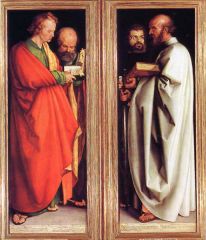
|
Albrecht Durer Four Apostles 1523-26 change to protestantism profoundly affected art- getting back to brass tacks by removing saints and mary. the apostles are all good tho. john and paul in front, peter and mark in back. they hold books-represents adherence to texts. notice it isn't a triptych- in those the central panel would usually hold the virgin. |
|
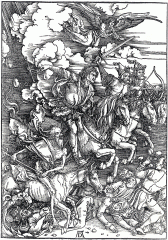
|
Albrecht Durer The Four Horsemen of the Apocalypse 1497-8 these images of apocalypse were in high demand as 1500 approached shows plague war famine and death prints were for intimate viewing, together by friends in an album rather than on wall. unusual subject matter. |
|

|
Albrecht Durer Adam and Eve 1504 copperplate engraving carved with burren. very highly detailed- moment before the original sin, notice cat and mouse eye each other but do not fear each other. animals all symbolic of 4 humors, cat, elk, ox, rabbit. adam and eve have vitruvian proportion. |
|
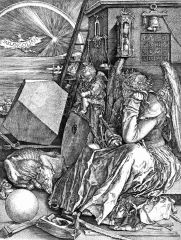
|
Albrecht Durer Melencholia I 1514 date concealed in magic square. compare the figure of melancholy to michelangelo in Raphael's School of Athens- the melancholic artistic genius. she was the source of Divine inspiration. Durer probably identified as well. lots of mathematical and engineering tools are scattered at bottom. |
|
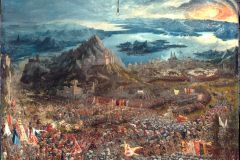
|
Albrecht Altdorfer Battle of Issus 1529 painted for duke wilhelm IV of bavaria. the year saw the first of many Turkish sieges of Vienna- the city gates of europe were being assaulted by nonchristians. alludes to modern battle through the classical battle of alexander and darius. almost infinite landscape, we see day and night change, principal figures are barely visible in the swarm of humanity. world landscape is defined by extreme height and panoramic view, almost god's-eye. meant to suggest universality- universal impact of these events. |
|
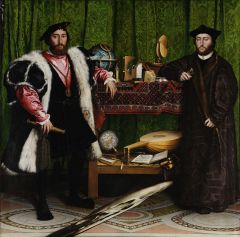
|
Hans Holbein the Younger The Ambassadors 1533 R is Jean de Dinteville, L is Bishop Georges de Selve- probably in England to deal with henry VIIIs remarriage. Jean holds a dagger with his age, de Selve leans on a book with his. the objects between the men reflect their interests. 2 globes- celestial and terrestrial- discord rules earthly sphere. the skull is an anamorphic image only visible if you stand close and to the right. in upper L a crucifix peeks from behind curtain. we get an image of death and one of salvation mostly showoff purposes. |
|
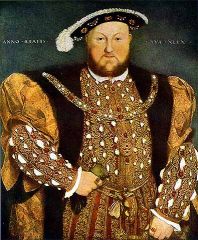
|
Hans Holbein the Younger Portrait of King Henry VIII 1540 henry VIII was holbein's principal english patron. compare the finery to bronzino's. lots of emphasis on lustrously painted clothing. captures king's self-confident attitude, bulk and unapproachability. molded tastes in british aristocratic portraiture. |
|
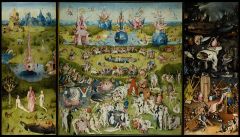
|
Hieronymous Bosch Garden of Delight (Earthly Delights) 1510-15 so anachronistic. outside is world landscape, earth a crystal globe like those in the hands of the salvator mundi. the inside is triptych. garden of eden is L, middle isthe human condition, little people strut and fret upon the stage doing freaky sex sh!t. R is hell scene. about vice, folly, but also human fraility. generous view of man's folly- we commit every sin but there's a fondness. |
|
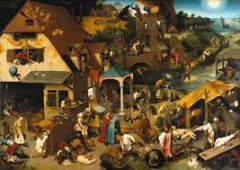
|
Pieter Bruegel the Elder Flemish Proverbs 1559 over 100 flemish proverbs, shown through life in a flemish village. influenced by bosch's compositions. high viewpoint-village seems to stand for whole world, stagelike. |
|
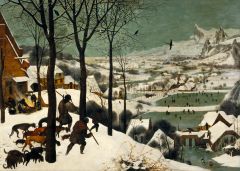
|
Pieter Bruegel the Elder Return of the Hunters Twelve Months 1565 high perspective- like a world landscape. fg and bg separated by a diagonal. both work and play are depicted. |
|
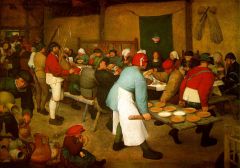
|
Pieter Bruegel the Elder Peasant Wedding 1565 a depiction of peasant festivities that brings up question of class in Bruegel's work. italian perspective in full effect. a brutal depiction of country folk- sort of to be laughed at but also to charm. |
|
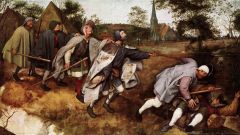
|
Pieter Bruegel the Elder The Blind Leading the Blind 1568 basically an enlargement from flemish proverbs. strong downward diagonal pull from standing to fallen men- you know where this is heading. a church partially obscured in bg of this secular painting. does the church have to do with figurative blindness? visual interpretation of verbal wisdom. |

